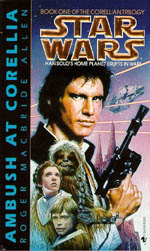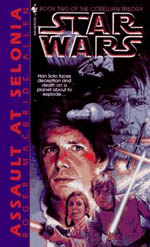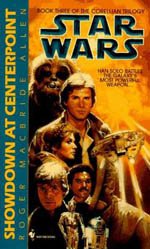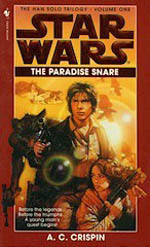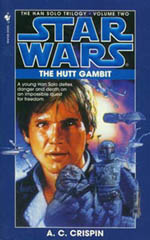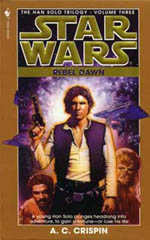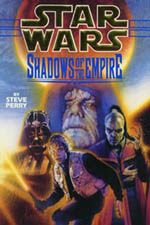A few years ago I was asked, based on my analysis of the intrigues of the prequel trilogy, to share my thoughts on what a sequel to the original Star Wars trilogy would look like. The result was the following essay. Originally written shortly before the release of Revenge of the Sith, it has been given a minor revision to take into account the particulars of that last film.

EPISODES VII, VIII, and IX
Everything I’ve read would seem to indicate that George Lucas originally intended for Episodes VII-IX to be the “Further Adventures of Luke Skywalker”, and that a lot of that material got rolled into Return of the Jedi. (Although, of course, the story fluctuates.)
But let’s speculate.
Each STAR WARS trilogy would seem to be formed of two components:
(1) A Star War. In the original trilogy this was the Rebellion. In the prequel trilogy this is the Clone War or the Separatist Civil War.
(2) The Skywalker Saga. To some extent this can be thought of as “the story of Anakin Skywalker” — and Lucas has certainly tried to spin it that way in pulling his dramatic commitment back to six films – but the reality is the prequel trilogy is the story of Anakin and the original trilogy is the story of Luke. Anakin’s story certainly continues into Luke’s, but claiming that the focus of the second trilogy is Anakin’s redemption would be wildly inaccurate.
So what might a sequel trilogy look like?
Well, first off we need a star war: It’s right there in the title. What would it be? The Extended Universe certainly shows us some intriguing possibilities, ranging from a resurgent Empire to intergalactic invaders. But here’s my thought: A Droid Uprising. (Obi-Wan: “If druids could think, there’d be none of us here.”) There’s a rather serious disconnect between the attitudes we see people holding towards druids in the Star Wars universe — whether it’s Obi-Wan’s off-hand comment or the casual wiping of droid memories — and the intelligent, independent, and sentient behavior we actually see droids like C3-PO and (particularly) R2-D2 engaging in.
R2-D2 as leader of a Droid Rebellion? Nah. That’s a little too weird. But what about Grievous, the Droid General? Obi-Wan may have thought he destroyed him by burning out the organic organs in his chest, but what if those remains were recovered and preserved? (The most obvious questions would be, “By who?” and “For what purpose?”) Combine these speculations with the very old rumor that a character from the prequel trilogy would be frozen in carbonite only to return in the sequel trilogy and you start getting some very interesting synergies.
Let’s turn our attention from that and take a look at the Skywalker Saga for a moment. From what we’ve seen, the Skywalkers seem irrevocably tied up with the Prophecy of the Chosen One. Now, frankly, I’m still pretty damn hazy on exactly what this Prophecy is all about. What, exactly, does it mean to “bring balance to the Force”? The obvious interpretation of the words seems rather belied by the fact that none of the Jedi say, “The Chosen One? Kill him now before he can revive the Dark Side in order to balance out our massive success as practitioners of the Light Side of the Force!”
(Tangent: One interesting theory I came up with a while back was the idea that the whole Skywalker-as-Chosen-One thing is a red herring. What if Palpatine is the Chosen One who brings balance by orchestrating the destruction of the Jedi, whose wide-spread use of the Force created unnatural imbalances? It doesn’t fully track, but it’s an interesting thought.)
In any case, there’s actually two questions here: What do the Jedi THINK the Prophecy means? And what does the Prophecy ACTUALLY mean?
I’m not sure what the Jedi think the Prophecy means, but I believe that what the Prophecy actually refers to is the finding of a third path: A balance within the individual Force-user between the Light and Dark sides of the Force. A healing of the philosophical schism which occurred when the Sith and the Jedi parted ways a millennia ago, the former succumbing to self-destructive egomania; the latter becoming the caretakers of a stagnating civilization.
In such an interpretation, the Chosen One is not, of course, Anakin: It’s Luke. And what we see in Return of the Jedi is not just the rebirth of the Republic, it’s a rebirth of the Jedi. It’s not just a return of the Jedi wiped out twenty years before: It’s a return of the True Jedi, whose path was lost in an artificial schism.
(REVISION NOTE: The Jedi’s interpretation of the Prophecy would appear to rely on the dichotomy between the Living Force (sensitivity to the moment arising from the interconnection of all things) and the Unified Force (the binding nature of the Force which results in destiny and shapes the future). Finding balance between these two sides of the Force would be seen as a positive way to escape the stagnation inherent in the Old Jedi Order’s reliance upon the Unified Force.)
Now, in the Extended Universe, we’ve seen a persistence of the old Light/Dark dichotomy. But, personally, I believe that Luke’s teachings would be influenced by that moment in Return of the Jedi where he opened his heart to the Dark Side… and DIDN’T fall. His New Jedi Order would be a rediscovery of how to walk the Path of Balance.
Where does all that take us? I’m not sure. But let’s talk about the Skywalkers some more. Looking at the Star Wars saga from a structural standpoint, we also see a generational transition between the trilogies, and I would expect to see the same thing happen again with the sequel trilogy. The Skywalker(s) at the center of the sequel trilogy would be the children of either Luke or Leia (or both).
But what’s their story? In the prequel trilogy we see the Fall of Anakin Skywalker. In the original trilogy we not only see Luke avoid that fall, we also see Anakin’s Redemption. Is there a third angle to this story? Or is the cycle complete, and all we could see is redundancy?
(Another tangent: One of the things I find brilliant about the prequels is the subtle enhancement of Luke’s character arc in the original trilogy. Having seen only part of Anakin’s fall, I find that I “worry” a lot more about Luke falling to the Dark Side. Having seen only the original trilogy, Luke is clearly the Hero of the tale; you just expect him to resist temptation. But having seen his father — and Luke is so very much like his father — you can’t help but begin to entertain the worrisome notion that Luke could be just as vulnerable to temptation. But I digress.)
The Extended Universe, in fact, offers many faceted views of this fall-and-redemption cycle. Perhaps the least satisfying of these is Dark Empire — in which (MINOR SPOILERS) Luke falls himself and then finds redemption. Although there are a lot of interesting things about Dark Empire, Luke’s fall is not only a redundant telling of his father’s story, it also directly saps the power and conviction of the conclusion of Return of the Jedi. (The Emperor’s resurrection also detracts from the conclusive nature of Return of the Jedi, in my opinion.) Perhaps the most interesting is the Knights of the Old Republic computer roleplaying game, which I won’t spoil here for anyone who hasn’t played it. (You should.) Mara Jade is another obvious example here.
Perhaps the mirror here is one of letting Luke play his role as the Chosen One to save his children (or Leia’s children). Luke is the Redeemer. (Doc Brown: “It’s not you, Marty. It’s your kids!”) This, of course, raises the question of how Luke let things go wrong in the first place. (Maybe he wasn’t there? Maybe Luke disappeared years ago and part of the story of the new trilogy is figuring out where he went and why.)
The larger problem with such a story, though, is its inherently unfocused nature: Is it a story of the kid’s fall? Their redemption? One or the other has strength. Both in the same arc would tend to make them a pale imitation of the previous trilogies (each of which was allowed to focus on one theme over the other).
Let me make a major digression here and look at the trilogies from a Campbellian perspective: It’s interesting to note that Lucas takes a Campbellian hero cycle and, to at least some extent, extends it into a generational epic. Shmi Skywalker is the metaphorical World Goddess, her virgin womb the wellspring of the Skywalker hero-legacy. In Anakin the promise of the hero (Chosen One) is twisted as his hero-journey is warped: The corrupted nature of Anakin’s reunion with his mother lays the seed; the death of one father-figure (Qui-Gon) and the failure of another (Obi-Wan) open the door for the corrupted father-figure of Palpatine to turn Anakin’s Apotheosis into a Fall. The result is the transformation of a hero-cycle into a Greco-tragedy.
But the hero-seed of Shmi Skywalker does not end its journey in Anakin Skywalker, it jumps to Luke. In this way Lucas raises Campbell ‘s cosmogonic cycle from a single hero and extends it to the Skywalker family as a whole. Luke’s hero-cycle, unlike that of his father, cannot be corrupted.
Campbell writes: “Two degrees of initiation are to be distinguished in the mansion of the father. From the first, the son returns as emissary, but from the second, with the knowledge that ‘I and the father are one’. Heroes of this second, highest illumination, are the world redeemers, the so-called incarnations, in the highest sense. Their myths open out to cosmic proportions. Their words carry an authority beyond anything pronounced by the heroes of the scepter and the book.”
Luke is a hero of the second sort: “I am a Jedi… like my father.” And Luke is also given his father’s blessing: “Tell your sister you were right… You were right…” This indoctrinates him as the Redeemer.
(Actually, Lucas’ working of the hero-cycle at the end of Return of the Jedi is both intricate and subtle. Campbell also writes: “Stated in direct terms: the work of the hero is to slay the tenacious aspect of the father (dragon, tester, ogre king) and release from its ban the vital energies that will feed the universe.” Luke doesn’t actually slay his father, but metaphorically the content is obviously there. More subtly, however, is the fact that Anakin’s moment of redemption is ALSO a father-slaying: The warped father-figure of Palpatine.)
But there’s one major leg of the cosmogonic hero-cycle missing here: The hero’s return. The Redeemer’s revolution and transformation of society. This would seem to be Luke’s destiny, with his revolution being the New Order of True Jedi walking the Path of Balance and his new society being that of the New Republic . (This is also an interesting mirror with Anakin: In Anakin’s failed apotheosis we see the destruction of the Jedi and the fall of the Republic. In Luke’s successful apotheosis we see the founding of a new Jedi Order and the return of the Republic.)
So if the sequel trilogy is the story of Luke as Redeemer, wouldn’t that mean the sequel trilogy would focus on Luke and not the next generation of Skywalkers? Not necessarily. No moreso than the story of Anakin’s redemption was told to us with Anakin as the focus of the story. Indeed, part of the strength of the STAR WARS saga to date is the fact that the second half of Anakin’s story became merely part of Luke’s story: A large tapestry woven into an even larger saga.
So, how would we see Luke’s story as the Redeemer and World-Changer similarly reflected as being merely a part of the larger story of his children?
It would definitely be interesting to see how Lucas would answer that question.
But for our own entertainment, let’s throw a few pieces out on the table and see what happens with them:
A DROID UPRISING
This is the central crisis on which we hang our plot. It’s the focus of tension and conflict, and provides all the pretty pyrotechnics you need for a grand space opera. It grows naturally out of the themes and elements we’ve already seen in the STAR WARS saga, while also staying true to the saga’s basic palette of classic, Golden Age science fiction.
MARA JADE
Mara may belong to the Extended Universe, but her love story of redemption is so perfect in the role of Luke’s wife that if she didn’t exist we’d have to create her. (And it wouldn’t be the first time that a creation of Timothy Zahn’s Thrawn Trilogy made the jump to the big screen.) She wouldn’t necessarily be the Mara Jade of the Extended Universe, but she would be a Force-using servant of the Emperor who comes into direct conflict with Luke in the struggles which follow the destruction of the second Death Star. Although all of this would have happened off-screen, in her redemption we have the dark temptress transformed into the life-womb of the Skywalker Children. Speaking of which…
THE SKYWALKER CHILDREN
Here I see influence from the Children of the Lens (E.E. “Doc” Smith). The twin daughters of Luke and Mara; the twin sons of Han and Leia. They form the nucleus of the New Jedi Order, and their collective hero-cycle redemption is the thematic core of this third act in the Skywalker Saga. But the journey will not be smooth or predestined, for the twins are fated to be pitted one against the other.
THE NEW JEDI ORDER
In this we see Luke’s role as the Redeemer. Although twenty years have passed and the foundations of the New Order are already becoming firm, in its mere existence we can see the fruits of Luke’s apotheosis. The Order is the backbone of the New Republic, and the Skywalker Children are the nucleus of the Order: Thus we see how Luke’s role as the Redeemer is subsumed into the hero-cycle of his children.
A GRAIL QUEST
The Arthurian Grail Quest is an inversion of the hero-quest, in which the hero-quest itself becomes a tragic form. What would the grail-object be in the world of STAR WARS? I’m not sure. But in a grail-quest we would see that elusive third facet of the hero-cycle: In Anakin we see a failed hero-cycle lead to tragedy. In Luke we see a successful hero-cycle turned to apotheosis. In the Skywalker children we would see a grail-quest in which some would rise to ascension and others would be debased.
THE DISAPPEARANCE OF LUKE SKYWALKER
After the world-change, the hero must depart — it’s the final stage of his existence. In the case of Luke, his disappearance would not only play a part in triggering the crisis which initiates the hero-cycle of his children, it would also be the breadcrumbs on the path which would lead them to the grail-quest.
And how about some droid Force users? Or, rather, not Force users. Because the Force binds together *living* things. But if that’s the case, who are the Droid Knights? And how can they do the things they do?
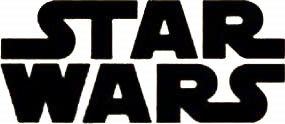
EPISODE VII: THE FORGOTTEN SHADOW
The last remnants of the Empire have been swept away at the Battle of Talame. But in the aftermath of victory a dark mystery prevails: At the height of the battle, Jedi Master LUKE SKYWALKER vanished, his ship disappearing without a trace.
As the galaxy searches for the lost Jedi Master, Luke’s wife, MARA JADE, and his daughter, AMELIA, are dispatched to the Republic shipyards at Halon Prime, to investigate the facility’s sudden communications silence.
Meanwhile, on the small world of Pelori IV, an ancient menace has returned — an old threat for a New Republic …
Pan down to the ship of Mara and Amelia, running silent through intergalactic space. Cut inside to a brief conversation between Mara and her daughter. Even here, a micro-jump from Halon Prime, there’s no sign of any communications in the system. They jump. After a few seconds, they drop out of hyperspace into catastrophe: Hundreds of ruined Republican ships litter the starways, their still-burning hulls drifting listlessly through an endless field of debris…

